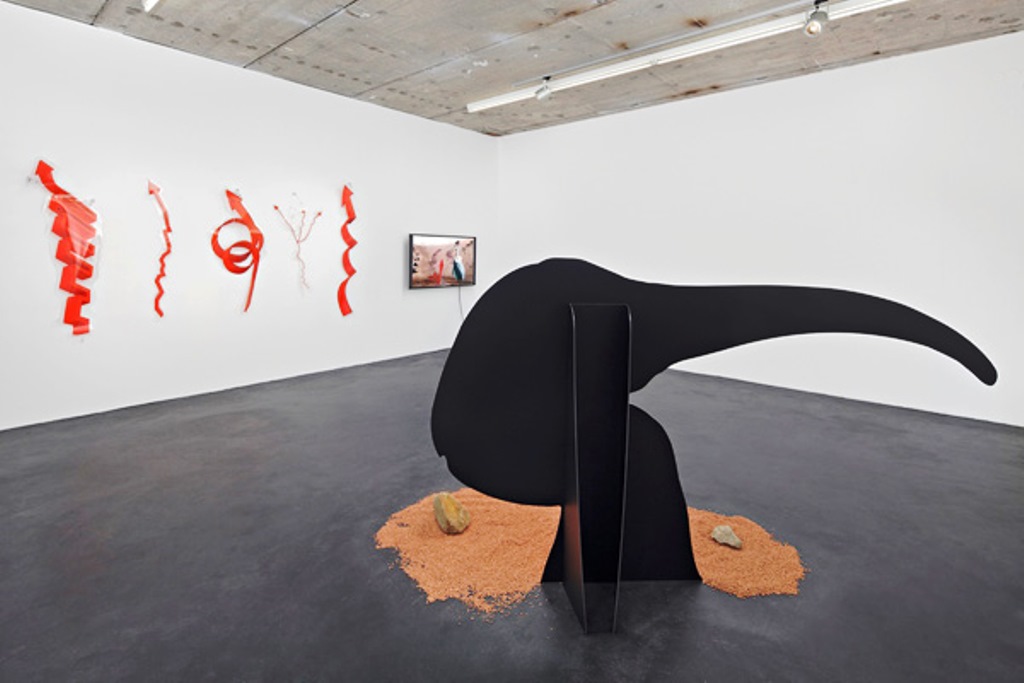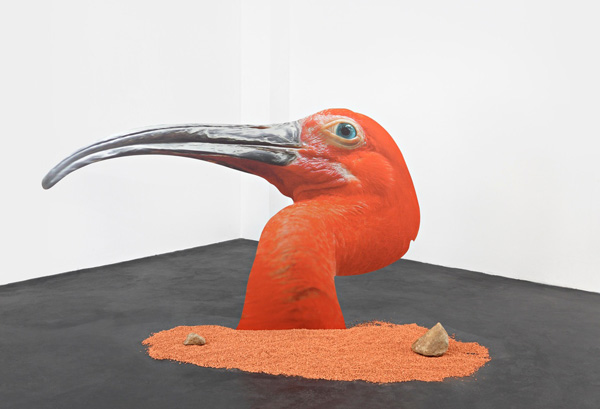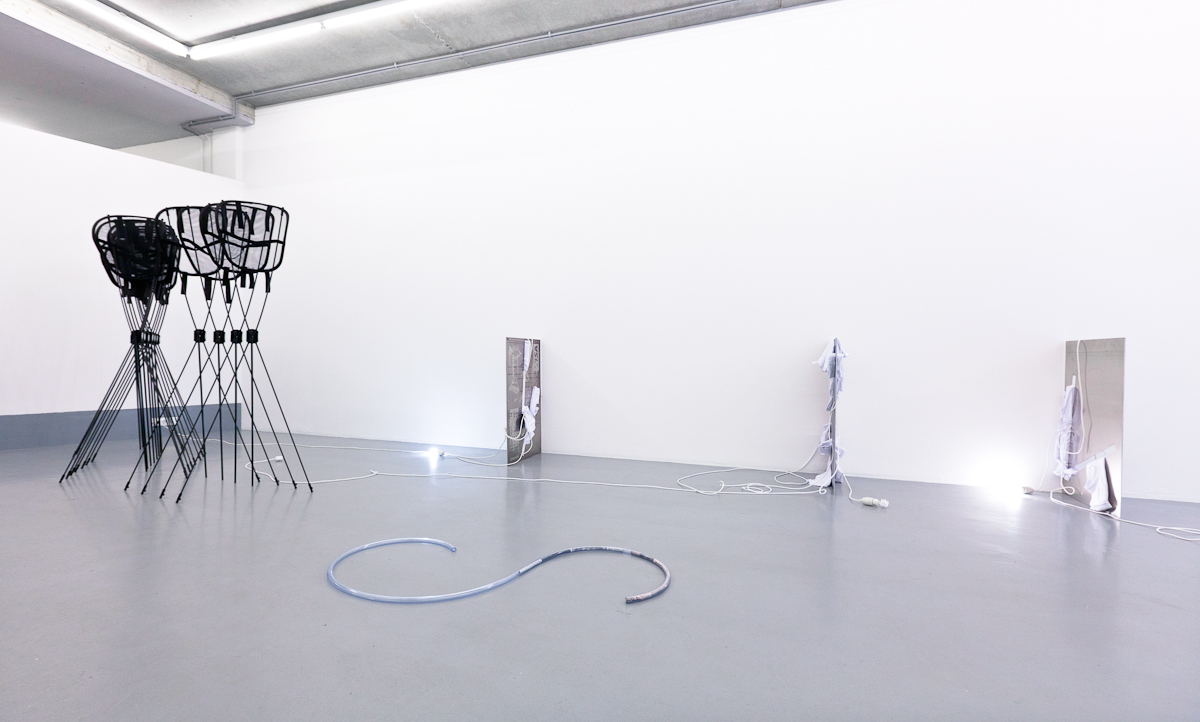
Post-Internet Materialism Martijn Hendriks & Katja Novitskova

What does materiality mean in the Post-Internet era? What is the relation between a jpeg and a sculpture? And what are the material effects of immaterial processes like image circulation and repeated translation? The artists Martijn Hendriks and Katja Novitskova talk about materiality, the object, neo-materialism and the importance of internet in their work.
Martijn Hendriks:
I think we should start by pointing out the potential strangeness and radicalness of the material object in recent sculpture that can be described as neomaterialist or post-internet. I was reading Joshua Simon’s book Neomaterialism and the surprising thing is that although his theoretical perspective is interesting, I don’t think he showed the strangeness of the object in much recent art. There are a number of good things in his book. He describes a new kind of materiality that is produced by processes aiming for dematerialization. In this new material world, symbols behave like materials and objects gain a certain subjectivity. Instead of considering the complexity of this however, he proposes an all-inclusive concept of the commodity, which for him absorbs the other terms often used to speak about art works such as the object, the piece, the artifact, the thing and the product. As an effect, his notion of the commodity becomes a catch-all phrase and a little muddy. It’s hard to talk about the unruly qualities of the object in art through the framework of the commodity as an unavoidable meta-material.
Although there is no doubt that the idea of neomaterialism as Simon proposes it is timely, I also think this new kind of materiality is actually much messier, stranger, and less monolithic than it seems. For example, what is being made tangible in sculpture today has changed from a few years ago. There’s a different attention to how objects materialize technological relations, to network effects, to how things form alliances and bonds in order to survive in the attention economy, social networks and their ubiquitous fear of missing out, and the overall digital madness of the contemporary world. By talking about these matters through objects, you could say we produce material things stating the immaterial state of things.
We both often start out in our work with images and other material that comes from the Internet, yet we translate them into physical objects. And subsequently these objects circulate online again as images. We could describe this as a situation in which things slip into and out of materiality, going between source image, work, documentation image, and so on. How do you approach or think about this process?
Katja Novitskova
Hmm, yes I think it is good to mention this trajectory of how even a few years ago there was no concept of post-internet, and the concept of new materialism was largely absent from the contemporary art-world, at least in its present cluster of meanings. Within a decade the world changed quite a bit. Internet expanded in scale and reach into social life, smartphones were introduced. Today everyone seems to be online; the state of mind and being we label post-internet is the new normal. One of the things that happened in between then and now is the merge of the physical and digital/symbolic (you mentioned Joshua Simon, for example), the line between the two became blurry and obviously so. So the most important effect of that happening is, in my opinion, that we saw the physical world of objects, animals and society to be similar to software, and we saw the digital objects and online activities to be as real as anything else we were used to ‘offline’. Every jpeg rendered on a screen consumes actual mostly fossil-fuel energy, atoms are as easy to manipulate as Tetris if you have the right tools, and every living creature is driven by a complex code in its cells. The internet of things does not only mean that things are all interconnected in networks, but also that the networks themselves are ‘things’, as well as the rules, mechanisms and self-aware participants of those networks. So what that gave us is a possibility to see and render materiality in a new way: not limited by the reductionist or dialectic or essentialist understanding of what constitutes forms, where things start and where they end.
As someone who started to make art around the same time Facebook became global I am used to the ease of translation between off and online, to the idea that art objects can and sometimes need to exist in several file formats, copies and physical editions. A jpeg of a sculpture and a sculpture are related, but they can have separate lives in their respected environments, on different platforms. They both constitute my ‘practice’ and experiencing an image of a work is experiencing my work. The cycle — internet surfing, image-finding, sculpture-making, sculpture-exhibiting/selling, documentation-making, image-uploading — all as a work, is just something that as you say makes things more tangible, or matter- and network-aware.
My personal interest lies somewhat in taking that banality of likes, popular blogs, images and million-viewed animal videos seriously. Why is it there and what does it say about human beings, art and the world in general, and most importantly, what kind of forms emerge from the over-abundance of visual information?

Martijn Hendriks:
Perhaps to say something about materiality today we should be talking about multiple, different materialities instead of one. What is obvious everywhere around us is the blurring of boundaries; most obviously those between objects and images, physical matter and the digital and symbolic, but also between art works and networks, the natural and the synthetic. But I don’t think these blurring materialities are therefore necessarily more alike. As you say, a jpeg of a sculpture and an actual sculpture are related but can have separate lives. An image circulating online enters into different relations than a physical object, even when we don’t find one more relevant or compelling than the other. In terms of Graham Harman’s Object Oriented Ontology, they are equally objects when one considers the object as a unified thing with a multitude of features. And this is where it becomes interesting, because even though the boundaries between them have blurred vis-à-vis their role in the art economy, jpegs of sculptures and physical sculptures lead different but connected lives. They have different qualities and are of a different materiality, yet they are entangled with each other continuously.
In my current work this led to the question of how one materiality can be affected or contaminated by another materiality, and how bonds and assemblages between sculpture, images, internet memes and networks lead to the emergence of what you describe as new forms. Could you say something about the qualities or features that distinguish the physical objects in your work and their lives as images? It’s interesting to me that in many of the documentation images of your work, aspects like the ‘frontality’ of the cutouts effectively position the viewer. But there is also always a side to your objects that doesn’t ‘pose’ as an image; a backside, the material of dibond, the question of size or a work’s physical relation to other works. It seems to me that the physical, material object, so not just its network abilities but also its unruly presence as a thing, is becoming interesting again in many new ways at this moment, and I’m trying to put my finger on why or how this is.
Katja Novitskova:
Yes I agree, blurring doesn’t mean everything is the same and everything is equal. A jpeg of a sculpture and a sculpture have different properties and capacities (De Landian words) based on what they are, their different ‘materiality’, as you say. A jpeg’s capacity to be easily shared by thousands of people is something a heavy sculpture doesn’t have. Sculpture’s three-dimensional sensory effect on our visceral system is something beyond reach for an image file on a screen. From these multitudes of features unique trajectories emerge of how they exist in the world.
Most of my sculptural works begin as digital collage sketches of found images. As a ‘backdrop’ I usually try to use images of art-spaces that the work will be exhibited in for the first time. So in that sense it is almost context-specific from the start. This creates a space of possibilities in which the visual composition of the image on the screen is directly related to the spatial composition of the resulting installation in a room. Both are equally important. With cutouts I also make sketches for both the ‘front’ and the ‘back’ view. So things like sizes, distances between things are decided at this stage, sometimes almost intuitively, based on the sketch. The more I know about the exhibition space in advance, the more similar is the final work to the sketch. But there are almost always nice surprises. For instance, I did a group show this year in Kassel at Fridericianum and I knew very little about the space I was getting. The final installation looks very different from my sketches and one work had to be not used at all, but I got the proportions right and was able to play with the objects in the space. The next step is documentation. If possible I always try to be present and work with the photographer who takes images of the work. I have a set of angles in my mind that I need to end up as images. Very particular things start to matter in the process of documentation framing, like the amount of floor in the image, the angle of the camera view. The images are then Photoshopped again and end up online as new ‘content’ to be shared. This occurring cycle of elements translated between different material and value states is all my work. Is sculpture-making and image-making related for you in any way similar to what I described?
Martijn Hendriks:
There are many similar moments in my process. However I think that the roles of found images, photoshopping and circulation have changed in my work since it started becoming more object-based and it became less about images than about the entanglement of matter with the models of networked circulation that affect it. The starting point is still often a text or an image that I come across online but it’s almost always followed by multiple layers of translation that reformat it into something hardly recognizable that can be equally compelling to me without re-using the original source. Probably as a response to doing and seeing a lot of work as digital images and on the Internet I started to ask myself increasingly how the physical materiality of an object is re-informed by the way we organize, produce and consume digital material every day. These two modes of being continuously affect and contaminate each other. You could say I started understanding my work as speculating about the strange materiality of the object in the post-internet moment. So for example, how can a material, physical art work relate to a world that is characterized by endless image circulation, translations and mistranslations, buzz, news feeds, licensings, subscriptions, likes, following and unfollowings, friending and defriending, accumulating strategies, seeding and leeching, caching, scanning, leaking, favoriting, ranking? The normalization of these processes by the internet extends into the material world of objects and bodies and, as I see it, produces a dispersed material state of things, forever falling apart and coming together in new constellations in which the boundaries of the object are continuously broken down and renegotiated. In my most recent works these issues translate themselves into questions of disintegration and contamination. So it’s more about questioning the virtuality or immateriality of those processes of translation, circulation, reformatting, etc, and registering them in material terms.
I often post works online before they’re finished and I like what happens when they are reposted on tumblr, or when they appear in totally different contexts than the studio or a gallery. These things often trigger a next step in a work or in a series. This is also why many of my works exist in different versions, like my numbered works or the ‘Texts on the Internet’ series in my recent solo exhibition at WCW Gallery in Hamburg. There is a potential activated when a sculpture circulates online in the sense of translating between what you call the different material and value states. This notion of translation as a material process is central to a lot of what I have been doing. In relation to this I wanted to ask you about the degrees of reformatting and translation in your work. If I look at your recent work, you stay very close to the source material in some works, almost to the point of treating found images as readymades. It is like you are copy-pasting the images into the exhibition spaces. Could you say something about this choice?
Katja Novitskova:
Web today is a space of content overloads and too much information. My instinct tells me that rather than making things even more complicated, juxtaposed and hard to take in, it makes more sense to isolate elements from the mess and expand them in a relatively empty space of a white cube or a book-spread. In my work Approximation I, the pair-bonding penguins couple is arching over the nothingness of a gallery floor. In the original image, they are standing in the sunset in Antarctica with their baby between them. Taking them out of that National Geographic visual trope allowed them to express other, perhaps more basic, qualities: nearly perfect visual symmetry, extraordinary beauty of their coating patterns, the simultaneously clumsy and ergonomic structure of their bodies. This is a way of seeing material properties we tend to use in sculpture and design, in the realm of human culture and technology. But the fact is these forms have evolved by themselves millions of years ago, for their own sake, long before there were humans to snap a photo around. Moreover, we are also a product of the same processes, and one can look at the whole existence of online images as our form of complex pattern coating. I find this idea breathtakingly inspiring, and my goal with each sculpture is to capture a different aspect of this immense formal variety native to our planet. The act of taking an online image and extracting a specific aesthetic trigger out of it into the physical space as art objects is just a process I am doing at the moment. In the future I imagine it will extend towards many more informational and material assemblages.
A Dutch translation of this text was published in Metropolis M No 2-2014


